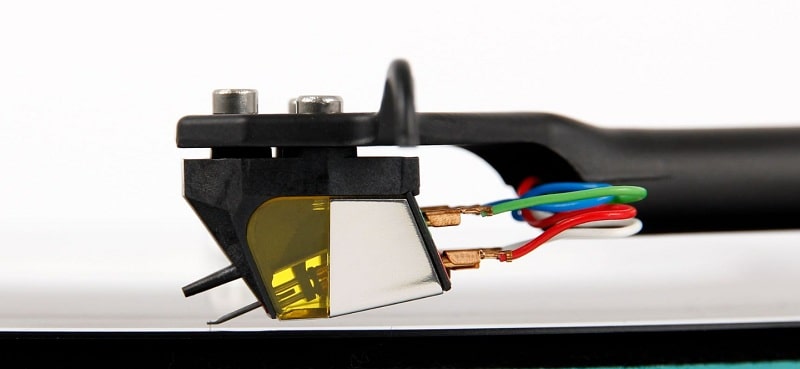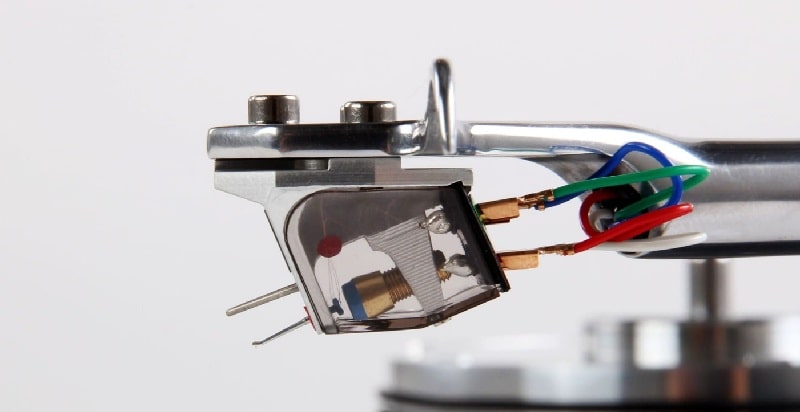You: Alexa?
Alexa: Listening…
You: What is the difference between a moving magnet and a moving coil cartridge?
Alexa: According to TurntableWave, a moving magnet phono cartridge has tiny magnets attached at the one end of the cantilever with wired coils inside the cartridge body, and on the other hand, a moving coil phono cartridge has wired coils attached at the one end of the cantilever with magnets inside the cartridge body.
You: Okay, so which phono cartridge is better?
Alexa: After comparing both cartridges in different aspects and considering all factors and our test results in mind, TurntableWave recommends you go for a high-end moving magnet cartridge.
You: Thanks!!
The conversation ended and you got your answer but did you understand the difference between moving magnet and moving coil cartridges, how they work, and why we recommend you go for moving magnet instead of moving coil?
Well, if the concept is that simple then why there is still an MM vs MC cartridge debate going on?
So, to help you understand better and end this MC vs MM cartridges debate once and for all, we have drafted this article in which we have covered everything you need to know about these cartridges in simple words. After reading this article from top to bottom, the whole confusion of moving magnet and moving coil will fly away from your mind.
But, before proceeding further, I want you to read about different turntable cartridges available in the market, their types, and their working concept which will help you understand the MM and MC concepts a lot better. So I recommend you to check out this article about turntable phono cartridges.
Well, I hope you have gone through the suggested article and learned the phono cartridges concept so now, I am going to differentiate between these two popular magnetic phono cartridges briefly and after that, we cover everything in depth.
MM Vs MC cartridges (moving magnet Vs moving coil):
| Moving magnet (MM) cartridge | Moving coil (MC) cartridge | |
|---|---|---|
| Mass | More mass | Less Mass |
| Sound | Less detailed reproduction of original audio compared to MC | More detailed & better reproduction of original audio compared to MM |
| Cost | Less expensive | More expensive |
| Output volts | 0.003 V to 0.006 V | 0.0003 V to 0.0015 V (depending on the MC cartridge variant) |
| Durability | More durable | Less durable |
| User-replaceable stylus | Yes | No |
| Phono preamp | Standard mm phono preamp | (Head amp/step-up transformer with standard phono preamp) or (Phono preamp with moving coil cartridge support) |
So, this is the brief difference between these two magnetic cartridges and now, we are going to talk about these cartridges and their working principles separately and after that, we will explain the information mentioned in the table above in depth.
What is an MM/moving magnet cartridge?

The moving magnet cartridges have magnets attached at the one end of the cantilever and coils inside the cartridge body. Inside the cartridge body, the magnets attached to the cantilever vibrate when the stylus runs on the record grooves. These vibrations are caught by wired coils placed near the magnets and these wired coils convert the vibrations into electric signals.
What is an MC/moving coil cartridge?

The moving coil cartridges have small wired coils attached at the one end of the cantilever and magnets inside the cartridge body. Inside the cartridge body, the wired coils attached to the cantilever vibrate when the stylus runs on the record grooves. These vibrations are caught by magnets placed near the wired coils and these magnets convert the vibrations into electric signals.
There are 2 types of moving coil cartridges:
- Low-output MC
- High-output MC
What is a Low-output MC (LOMC):
LOMC or low-output MC is the real deal when talking about moving coil cartridges. The lower mass of the coils helps the stylus to read the grooves more accurately and in the end, you will get better detailed sound reproduction, low noise, and wider frequency response.
What is a High-output MC (HOMC):
HOMC or high-output MC has comparatively heavier coils attached at the cantilever’s end to increase the output volts. The heavier coils mean heavy mass and this heavy mass restricts the stylus to read the grooves accurately and in the end, the sound quality is compromised.
So, this is the brief description and working concept of these phono cartridges.
Now, let’s discuss the difference in detail.
Difference between moving coil and moving magnet:
Now, we are going to explain the difference in 5 different aspects one by one.
Mass:
Mass is the major difference between the MM and MC cartridges. This is also the main reason behind the more detailed and better original sound reproduction by the moving coil cartridges.
Well, the magnets are made from iron which makes them heavy while coils are much smaller than the magnets and also they are made from a very thin copper wire which makes them super lightweight.
In moving magnet cartridges, the heavy mass of magnets at the end of the cantilever restricts the stylus from tracking the grooves freely while on the other hand, in moving coil cartridges, the lightweight wired coils at the end of the cantilever ensure less downward pressure on the stylus which allows the stylus to track the grooves freely and more delicately.
This free and more delicately tracking of grooves by the stylus in MC cartridges helps in getting wider frequency response, improved transient response, and more detailed reproduction of original audio.
Let me explain this concept with a real-life example:
Take a pencil and some sort of weight that you can place at the end of the pencil. You can take an eraser with a hole in the center.
Firstly, try moving the pencil left and right on the paper without any weight. You will find out that you can move the pencil freely. Secondly, add some weight at the end of the pencil and try moving it left and right on the paper. You will find out that you need to apply some force to move the pencil.
This same principle applies to turntable cartridges and it helps MC cartridges to produce detailed and better sound quality than MM cartridges.
Sound:
Due to the mass concept (explained above), MC cartridges produce better sound quality and more details reproduction of the original audio.
Well, in the modern-day MM cartridges, this disadvantage is mostly removed by the manufacturers by using lightweight magnets, and some claim that they have moved the magnets closer to the fulcrum or pivot point of the cantilever which puts less mass on the stylus thus, allowing the stylus to track the grooves of the record more accurately and freely.
Output Volts:
The moving coil cartridge has a smaller size of wired coils at the end of the cantilever which makes the MC cartridges very less sensitive to the movements thus, making the MC cartridge output less voltage than moving magnet cartridges.
The moving magnet cartridge outputs between 0.003 V to 0.006 V or 3-6 mV depending on the variant you are using.
On the other hand, the mc cartridge outputs depends on its type. The low-output MC (LOMC) outputs less than 0.0003 V or 0.3 mV, whereas, the high-output MC (HOMC) outputs more than 0.0015 V or 1.5 mV.
Well, the output varies from cartridge to cartridge so I recommend you to check the manual of your cartridge to find the exact volts it outputs.
Cost:
Moving coil cartridges are more expensive than moving magnet cartridges due to their engineering, specialization, and the sound quality they offer.
Also, the additional head amp or step-up transformer is required if your existing phono preamp is not compatible with MC cartridges which makes the whole setup more expensive.
On the other hand, MM cartridges are cheaper and can also work well with most of the existing stereo receivers or powered amps with in-built phono preamps or standard external phono preamps.
Also, the coils in MM cartridges can be machine wounded while in MC cartridges, the coils at the end of the cantilever are carefully hand wounded which also increases the cost of production of MC cartridges.
Durability:
The MM cartridges have a simple design and also offer stylus replacement while on the other hand, the MC cartridges have a little complex design, and most of the time, it doesn’t allow stylus replacement.
Also, keeping other factors like cost, quality of material, and maintenance in mind, the MM cartridges are considered more durable than the MC cartridges.
User Replaceable Stylus:
The MM cartridges allow the user to replace the stylus easily while in MC cartridges, you can’t replace the stylus. If your stylus in the MC cartridge has worn out then you need to buy a whole new cartridge.
Phono Preamp:
As we have explained above, the MC cartridges generate less voltages compared to MM cartridges so, we first need to amplify the MC cartridge’s output to match the output levels of MM cartridges and then we can pass the amplified output to a standard phono preamp.
To amplify the MC cartridge’s output, we can use a head amp or step-up transformer device to amplify the signals to match MM cartridge signals or we can also use a phono preamp with MC cartridge support.
Keep in mind that if you use MM phono preamp for an MC cartridge then you will face turntable or record player so quiet issues.
So, these are the differences between moving magnet (MM) and moving coil (MC) cartridges.
Now, one question arises which cartridge you should prefer?
Which Cartridge is Better for You: MM or MC?
I will recommend you go for high-end moving magnet cartridges.
Now, you must be wondering that in the whole article, the MC cartridge has the upper hand in terms of sound quality and better vinyl experience but why I am recommending MM over MC?
Well, the answer is very simple. The moving magnet cartridges offer a lot of other things compared to moving coil cartridges like durability, a user-replaceable stylus, compatibility with a standard phono preamp, and most importantly it is a lot cheaper in price.
As I have already explained above, the major disadvantage is that the “mass” of the MM cartridge is mostly sorted by the manufacturers by using lightweight magnets with more magnetic field at the end of the cantilever, which puts less mass on the stylus and allows the stylus to track the grooves of the record more accurately and freely.
One thing more that I would like to tell you is that you will notice the magic of the MC cartridge only if your turntable supports it. If you use a low-output moving coil cartridge (the best in the game) on an entry-level turntable then the cartridge won’t perform well.
Leaving the turntable aside for a moment, there are a lot of other factors like tonearm mass, quality of the phono preamp, and stylus tip that either improve or degrade the sound quality.
So, if you are a beginner in the vinyl world or you don’t have a high-end turntable, you should go for a moving magnet cartridge. My recommendation will be the “Ortofon 2M Blue Cartridge” which is quite affordable, one of the best cartridges available in the market known for its detailed reproduction of original sound.
Frequently Asked Questions:
Q1: How can I tell if my cartridge is MM or MC?
I recommend you check the manual or the printing on the cartridge body to know the brand and model. After knowing the brand and model, you can find more information about the cartridge on the brand’s website or by googling the model number along with the brand.
Except that, there is no other way.
Some people do identify the cartridge type by just looking at its physical appearance, like coils, magnets, and wiring, but still, it is too advanced for a beginner or someone who has never examined the cartridge that deeply before.
Q2: Can I use an mm cartridge on an MC phono stage?
No, I won’t recommend using an mm cartridge on an MC phono stage. As the MC cartridge’s signals need much more amplification as compared to the MM cartridge’s signals, the MC phono stage will amplify MM signals more than required, which means overamplification of phono signals and your record player will sound distorted.
But if your MC phono stage has a switch on the backside through which you can switch to MM or MC mode or a different MM and MC terminal, then you can either switch to MM mode or transmit output from the turntable to the phono stage’s MM input terminals and use your MM cartridge on the MC phono stage.
You will get more clarity by looking at the image below:

Q3: Why are MC cartridges so expensive?
Moving coil cartridges are expensive due to their engineering, specialization, and the sound quality they offer. Also, the coils at the end of the cantilever are carefully hand-wound, which also increases the cost of production and makes MC cartridges more expensive.
Q4: Can you put an MC cartridge on any turntable?
No, you can’t put an MC cartridge on any turntable. You need to check the tonearm effective mass, mount type, and phono stage compatibility with the MC cartridge.
If you are planning to use a low-output MC cartridge (LOMC), then you also need to make sure that your turntable’s noise floor is low because if it is high, then the additional gains by the MC phono stage will also amplify the noise as well.
You can ignore the additional turntable’s noise floor check if you are planning to use a high-output MC cartridge (HOMC).
Here is a hack to make everything simple:
You can call or email your turntable manufacturer with your turntable specification and the MC cartridge specification that you want to use on your turntable and ask them whether it is compatible or not. You will get an instant and genuine answer without digging deeper into technical things.
Q5: How long do MM cartridges last?
The MM cartridges have a user-replaceable stylus. So, if taken care of, the MM cartridge body can last forever, while the stylus, which lasts about 800-1500 hours (depending on stylus tip and usage), can be replaced after being worn out.
Q6: Do I need a preamp for a moving magnet cartridge?
Yes, moving magnet cartridges need a phono preamp. Well, the phono signals are of lower volts and don’t have a flat frequency curve, so to amplify the phono signals until they reach line level (0.316V accepted by the amplifier or stereo receiver) and give signals a flat frequency curve, we have to use a phono preamp.
Q7: Are moving coil cartridges worth it?
Taking into consideration the benefits that the MM cartridge gives compared to the MC cartridge, we can say that upgrading to moving coil cartridges is not worth it. I recommend you go for high-end MM or MI cartridges instead.
Q8: What are the disadvantages of moving coil cartridges?
Here are the disadvantages of MC cartridges:
- Expensive
- No user-replaceable stylus. (Once the stylus is worn out, you need to replace the whole cartridge.).
- More magnetic and heavier due to the big magnets inside the body.
- Need a head amp, step-up transformer, or phono preamp compatible with a moving coil cartridge.
- If the turntable’s noise floor is high, then the additional gain by the head amp, step-up transformer, or MC phono preamp will also amplify the noise.
- Most importantly, you need a high-end turntable to hear and feel its glory.
Q9: What voltage are MC cartridges?
The low-output MC (LOMC) outputs less than 0.0003V, whereas the high-output MC (HOMC) outputs more than 0.0015V.
You can experience better sound quality using high-end moving magnet cartridges by setting up your turntable perfectly by adjusting the tonearm, tracking force and anti-skate, and cartridge alignment perfectly and also following vibration isolation techniques.
Now, the choice is yours. You can buy either higher-quality moving magnet cartridges, which offer a lot of things, or an expensive moving coil cartridge.
Comment below your thoughts about MC and MM phono cartridges.



Loved it. You did a great job, James.
You have covered everything in detail. After reading the article once, I understood the whole concept and the difference between these two cartridges.
Thanks for sharing.
Thanks, Will. Glad to help!